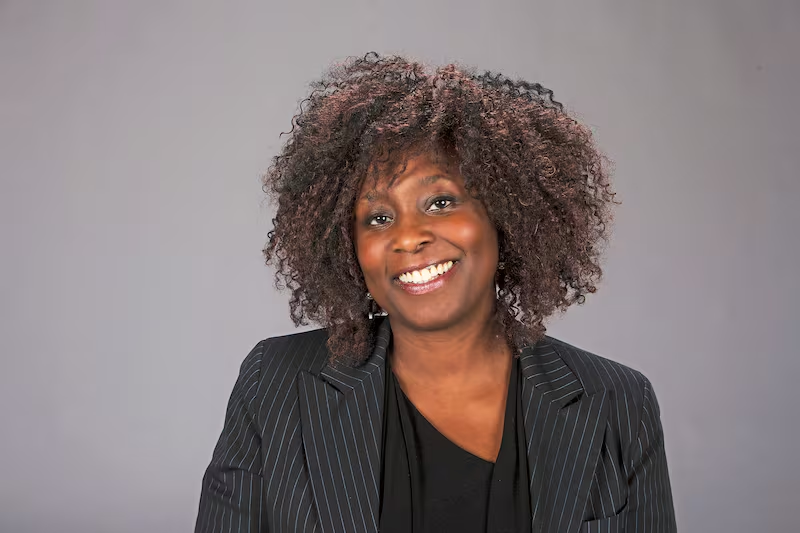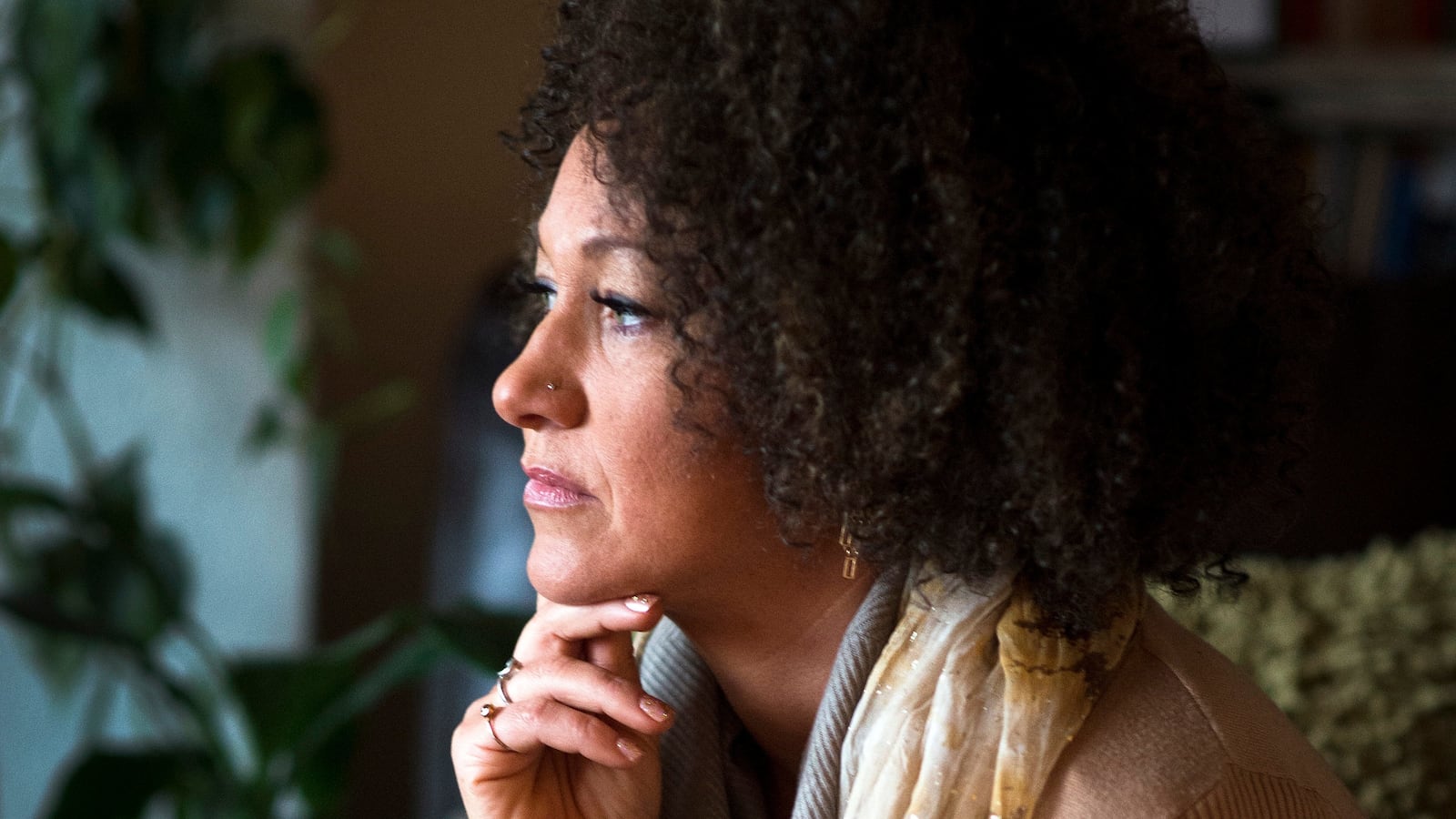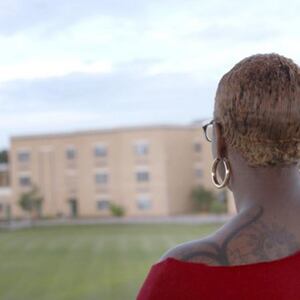In a film about Black beauty, societal pressures in today’s culture, and stereotypes that Black women have been pigeonholed into for decades, perhaps one of the last people you’d expect to appear on your screen would be Rachel Dolezal.
But there she was, the infamous “race faker,” in the new documentary Subjects of Desire by director Jennifer Holness that premieres this week at SXSW.
Dolezal sparked national outrage and bewilderment in 2015 when it was uncovered that despite presenting herself a Black woman, she was in fact white—so her cameo in the predominantly Black film is a head-scratcher, especially when she weighs in on feeling scared of white men and feeling that she had been forced into a “white mold.”
Holness agrees it may seem like an out-of-left-field decision but explains that if her film was going to examine appropriation and beauty standards shifting to include what’s commonly associated with Black features, such as curvy bodies and full lips, Dolezal had to be included.
“It wasn’t a commercial thought,” she tells The Daily Beast. “It wasn’t like I thought, ‘Oh my God, if I put her in, it’ll be controversial!’ No, not at all. I’m doing a film on Black women and beauty and this is the first time that I’ve come across a white woman pretending to be Black for 10 years when there wasn’t a massive financial benefit.”
“The standard of beauty historically has been white and that has been protected and upheld, so as someone who has that standard, she’s blonde with freckles and green eyes, and stepped away from that, there’s something there.”
That’s not to say that Holness doesn’t find what Dolezal did to be problematic. But she says to her credit, Dolezal is still living, by all accounts, as a Black woman in spite of the “hate” that Dolezal describes being subjected to.
“I would say since then [I’ve had] just shaming and ridicule,” Dolezal says in the documentary. “I’ve been called an insult to white women and an insult to Black women. White women are angry because I did what they never would do and went further, like I put 110. I didn’t just be that white ally and do a little bit, I canceled my white privilege. I canceled my hair. For Black women, I feel like it’s a reaction to pain. It’s like a trigger to post-traumatic stress.”
“When it comes to white men, that’s the group that I am the most scared of on a level of threat because that’s mostly the white supremacy folks,” she adds.
Dolezal, who was forced to resign from a leadership position at her local NAACP chapter and was let go from her job at Eastern Washington University as adjunct instructor of Africana Studies due to the scandal, now makes a living from her hair-braiding business.
She recalls in the documentary how her first husband, a Black man named Kevin Moore whom she married in 2000, tried to force her into a “white mold,” which caused her spirit to be “repressed.” “He would make comments about how no white woman has that kind of butt, you need to get a respectable white butt,” she says.
But Dolezal is only a footnote in Holness’ deep dive into Black beauty and the layers surrounding the topic, framing the film around the 50th anniversary of the Miss Black America beauty pageant in 2018. Established in 1968, the pageant was held directly in opposition to the Miss America pageant that initially had rules stipulating that only women of the “white race” were allowed to compete. While the rule was abolished in 1950, it wouldn’t be until 1970 that a Black woman entered into the beauty pageant.
Some of the women competing in the pageant, Ryann Richardson, Alexandra Germain, and Seraiah Nicole, share their experiences of being Black and feeling the need to conform to society’s standards of beauty in order to feel accepted or even attractive.
Richardson, who went on to be crowned the year’s winner, says in previous pageants where she was competing against white women that she was told she looked too harsh and severe, leading her to contour her face with makeup to soften her features. “Even my beauty doesn’t change that I’m Black,” Richardson says. “Black women historically have been denied the power of beauty, and I think it was intentional.”
Tearing up, Germain recalls how boys would make monkey noises at her on the playground after lunch. “It affected me in ways that I didn’t know that it would carry on into my adulthood,” she explains. “The eyelashes and makeup don’t mean anything. When you see a pretty girl, you don’t think they have issues. But when you don’t love yourself, you don’t love anything. I have to tell myself I’m beautiful.”
Holness shares she was inspired to make the film as a result of her three teenage daughters, hearing their experiences and thoughts about beauty compared to when she was growing up. She remembers how she used to be teased about the size of her lips, but now her daughters’ white friends praise their naturally full lips.

Filmmaker Jennifer Holness
SXSW“I think when you’re a mother, [I was] really hopeful that my daughters wouldn’t have some of the experiences that I did growing up, feeling out of place, not wanting to look the way you look sometimes and wanting to be something else.”
Holness says she thought with the availability of makeup shades matching their skin color and having ample representations in society of beautiful Black women, such as Rihanna, Beyoncé, and SZA, her daughters wouldn’t ever have to feel like the “other.”
But unfortunately, they were still “having those exact same experiences that I was having,” Holness says. “I think the conversation [with my daughters] was a little bit different, but it was also a little bit the same. The most surprising thing were white girls who wanted [bigger lips which] previously had been seen as unattractive.
“I just thought, ‘What’s happened here?’ I wasn’t paying attention to the Kardashians or any of those things, but I actually started looking into the level of appropriation that was happening and discovering things like Blackfishing. It seemed really surprising to me. I’d actually never seen anything that took a comprehensive look at the larger context because we kind of live in the space of it. Once you start looking at this larger history, I felt like that story hadn’t been told well.”
One of the most impressive and informative aspects of the film is the historical look into the stereotypes Black women are often typecast into: the Mammy, a plump, elderly, and nurturing figure; the Jezebel, the voluptuous, sexually-aggressive vixen; or Sapphire, the angry Black woman.
The first two characters were born out of slavery, as the film exposes that the idea of a mammy is often misconstrued. The slaves caring for their owner’s children were often slim, young girls. The film claims that this illusion of a sexually undesirable elderly woman was a ruse to hide the rampant sexual abuse that occurred. It was to cast doubt that a white man would ever choose this type of unattractive woman over his white wife, the societal standard of beauty.

A scene from the documentary Subjects of Desire
SXSWThe Jezebel stereotype was meant to push the narrative that promiscuous Black women couldn’t be raped—a defense used in the trial of four white men who raped Betty Jean Owens at gunpoint in Florida in 1959. The case is significant because all of the men were found guilty and sentenced to life in prison, a landmark decision at the time.
Including these history lessons were the most important and difficult parts of making the documentary, offers Holness, admitting that she was almost overwhelmed with the task of compiling centuries worth of information into just a few moments. “The breadth of material that is out there around this narrative of Black women was massive,” she explains.
She says she paid special care to the Jezebel section, not wanting to diminish or disrespect Black women who are confident and find empowerment through their sexuality. “It was about saying, let’s look at this,” Holness says. “Because what we might think is freedom could also be a part of a narrative around us. So, use your freedom, but be aware that this thing was concocted.”
“Those are the places where I really had to think through how I could deliver those pieces. The connections, for me, was about how unprotected Black women have been historically. That comes out of that history of indiscriminate abuse of Black women that’s never really been addressed or acknowledged. So, those are some of the things that I grappled with, how to deliver that in a succinct way.”
In the end, Holness hopes for Black beauty to be celebrated so that Black women don’t have to slowly learn to love themselves. She says the most special part of the process was watching the bonding and upliftment that unfolded between the women at the pageant, which was originally created in response to its racist white counterpart.
“The legacy is so important,” Holness says. “Black women have had to fight for every frickin’ thing. So then to see how beautiful it was, that’s the magic of sisters, man.”


